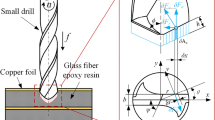Abstract
Drilling torque was estimated using the spindle motor current and controlled through feedrate manipulation for the reduction of drill wear. A PID controller was used to control the cutting torque measured indirectly from the spindle motor current. The effect of cutting torque control on drill flank wear was also investigated. Experimental results showed that the drilling torque was well-regulated at a given reference level and the risk of drill failure and drill flank wear were reduced remarkably through cutting torque control. Moreover, the suggested cutting torque control system does not disturb the cutting process and is practical in an industrial environment.














Similar content being viewed by others
Abbreviations
- I rms :
-
Root mean square value of spindle motor current (ampere)
- I u,v,w :
-
U, V, and W phase current of the spindle motor (ampere)
- I rms,c :
-
Spindle motor current due to cutting (ampere)
- I rms,t :
-
Tare current of the spindle motor (ampere)
- T c :
-
Cutting torque (Nm)
- T s :
-
Sampling rate (Hz)
- N r :
-
Number of revolution
- N d :
-
Number of data per revolution
- K I :
-
Spindle motor current gain (ampere N−1m−1)
- τ d :
-
Time constant of the spindle system (sec)
References
Boothroyd G, Knight WA (1989) Fundamentals of machining and machine tools. Marcel Dekker, New York
ASM International Handbook Committee (1989) Machining metals handbook, ninth edition. ASM International, Materials Park, OH
Fujishima M, Nishiura I, Kakino Y, Matsubara A (2000) Integration of adaptive control functions for drilling in intelligent machine tools. In: Proceedings of the Sixth International Conference on Automation Technology, Taiwan, 2000
Ke SJ, Yang SM (2000) Observer-based cutting force control for induction spindle motor drive. In: Proceedings of the Sixth International Conference on Automation Technology, Taiwan, 2000
Furness RJ, Tsao TC, Rankin II JS, Muth MJ, Manes KW (1999) Torque control for a form tool drilling operation. IEEE Trans Contr Sys Technol 7(1):22–30
Balazinski M, Songméné V (1995) Improvement of tool life through variable feed milling of Inconel 600. Annals CIRP 44(1)55–58
Lin TR, Shyu RF (2000) Improvement of tool life and exit burr using variable feeds when drilling stainless steel with coated drills. Int J Adv Manufact Technol 16(5):308–313
Altintas Y (1992) Prediction of cutting forces and tool breakage in milling from feed drive current measurement. Trans ASME J Engin Industr 114(4):386–391
Lee JM, Choi DK, Chu CN (1995) Real-time tool breakage monitoring for NC milling process. Annals CIRP 44(1):59–62
Kim GD, Kwon WT, Chu CN (1999) Indirect cutting force measurement and cutting force regulation using spindle motor current. Int J Manufact Sci Technol 1:46–54
Liu HS, Lee BY, Tarng YS (2000) In-process prediction of corner wear in drilling operation. Journal of Materials Processing Technology 101:152–158
Author information
Authors and Affiliations
Corresponding author
Rights and permissions
About this article
Cite this article
Oh, Y.T., Kwon, W.T. & Chu, C.N. Drilling torque control using spindle motor current and its effect on tool wear. Int J Adv Manuf Technol 24, 327–334 (2004). https://doi.org/10.1007/s00170-002-1490-0
Received:
Accepted:
Published:
Issue Date:
DOI: https://doi.org/10.1007/s00170-002-1490-0




